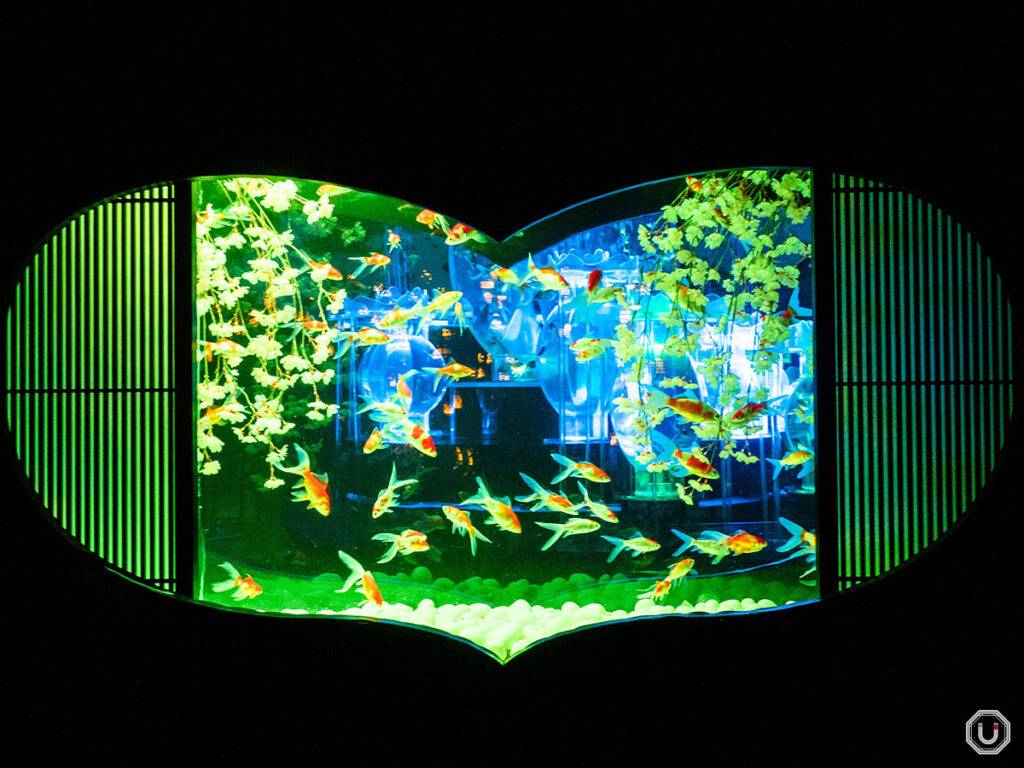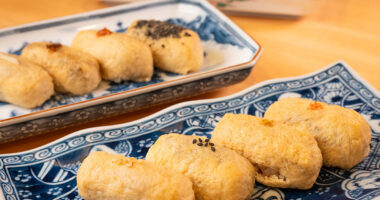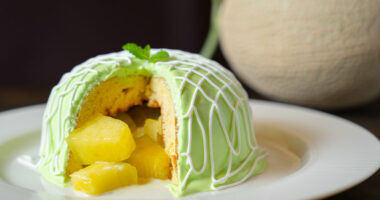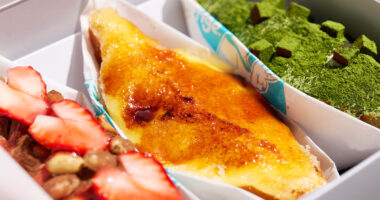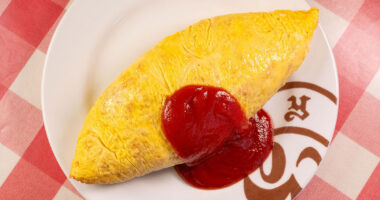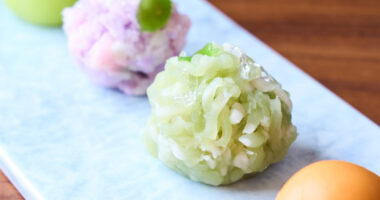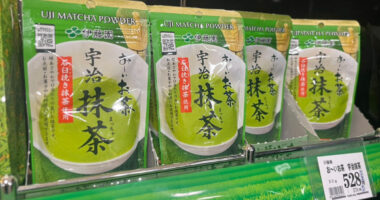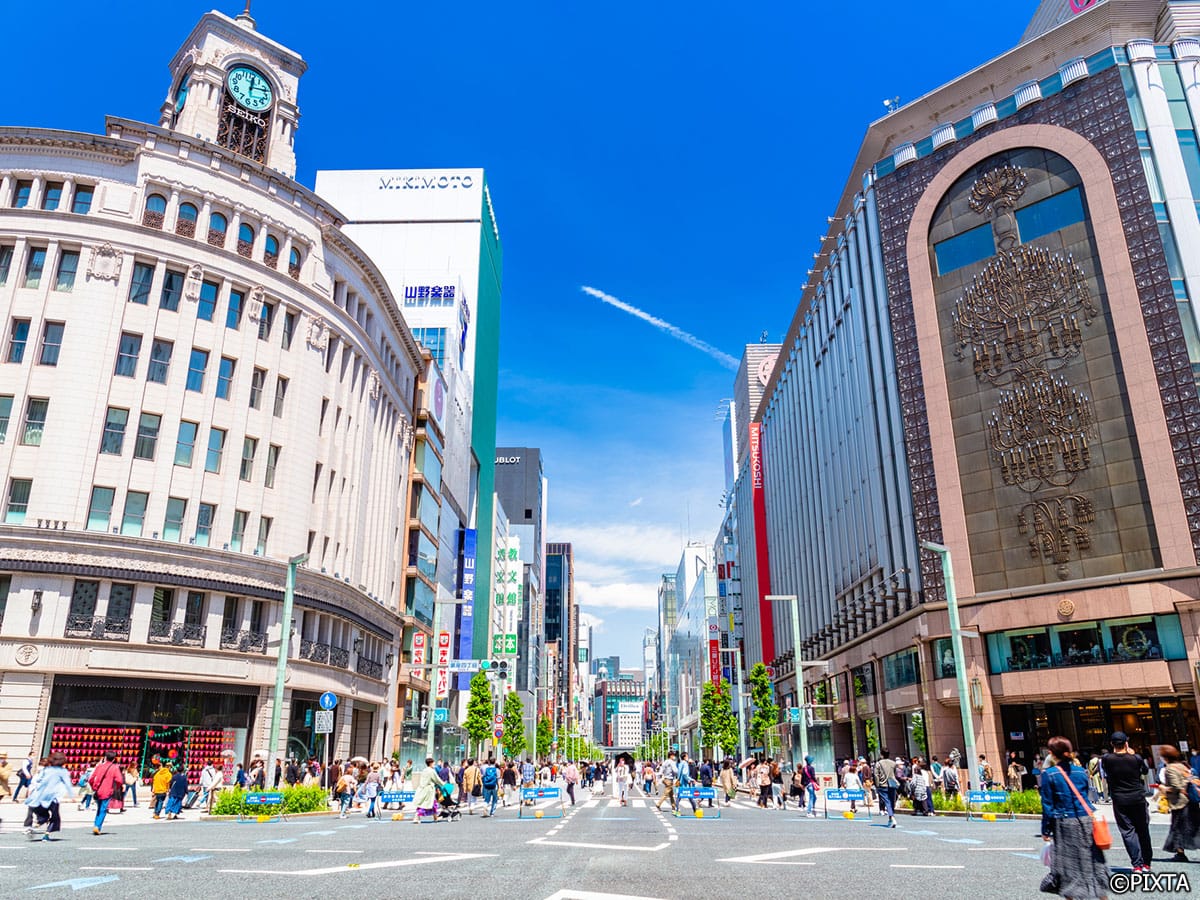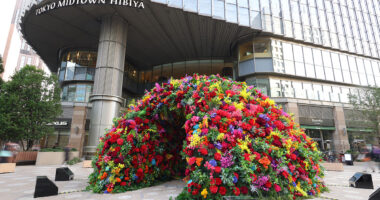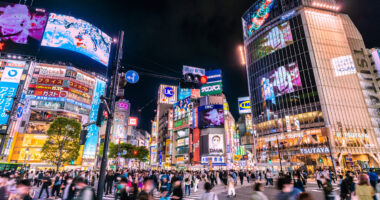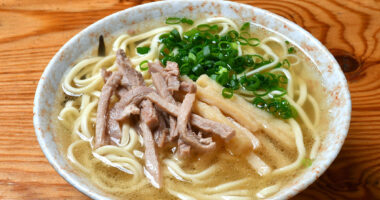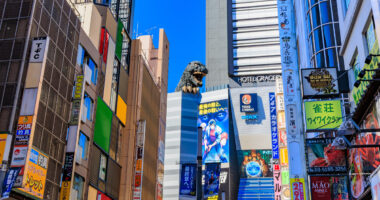Ginza is an area in Tokyo where tradition and innovation merge.
In recent years, Ginza has often been known as a high-end shopping district, but its appeal goes far beyond shopping.
As symbolized by the Kabukiza Theatre where kabuki is performed, Ginza has long been a center of arts and culture.
Even today, the area around Ginza Station is home to numerous museums housing artworks of significant historical value, including National Treasures.
Here we’ll introduce the artworks you can encounter in Ginza, along with the new and long-established museums that exhibit and preserve them.
Artizon Museum: modern Japanese Western-style paintings, plus works by van Gogh and Monet
The predecessor of the Artizon Museum, the Bridgestone Museum of Art, first opened in 1952 on the very same site where the current Museum Tower Kyobashi stands today.
Following the reconstruction of the Bridgestone Building, it was transformed into a 23-story office building integrated with the museum. With the completion of the new building, the museum was renamed and reopened in 2020 as the Artizon Museum.
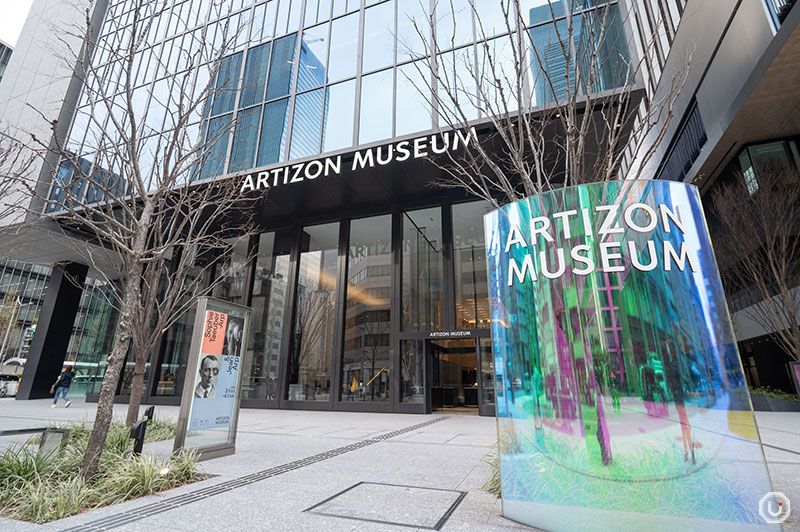
Exterior of the Artizon Museum
The Artizon Museum occupies floors 1 through 6 of the Museum Tower Kyobashi and is characterized by its vertically stacked structure.
Floors 1–2 and 3–5 feature open atriums, incorporating a design that creates space and openness while blending into the urban landscape.
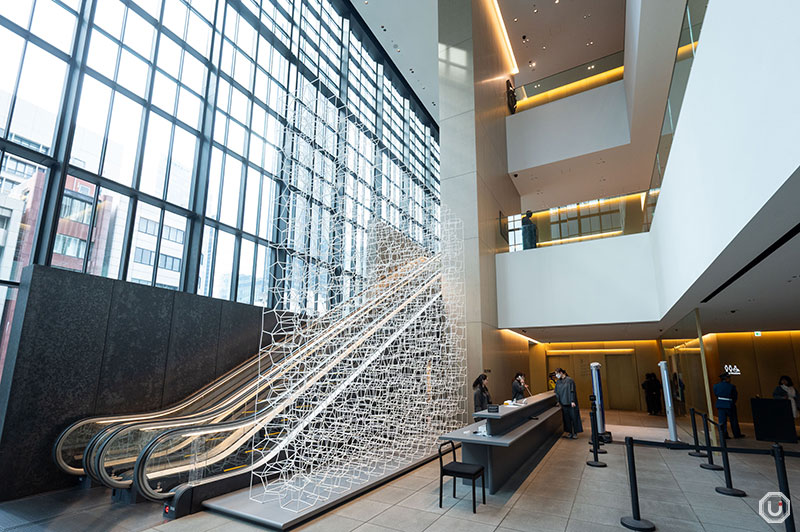
Lobby on the third floor of the Artizon Museum
Additionally, extensive use of cutting-edge digital technology services for visitors is a unique feature of the Artizon Museum, which opened in 2020.
By downloading the “Artizon Museum Official App” to your smartphone, you can use the audio guide in Japanese, English, Chinese, and Korean for free. Be sure to bring your own earphones when visiting.
On the fourth floor, you’ll find the “Digital Collection Wall,” another example of the museum’s use of state-of-the-art technology.
This large touchscreen display allows you to intuitively browse and explore artworks on a large scale with a simple tap.

The Digital Collection Wall, interactive for all visitors
Notable works
The Artizon Museum, founded on the collection built by Mr. Shojiro Ishibashi, the founder of Bridgestone Corporation, continues to collect artworks and now houses approximately 3,000 pieces.
Its collection spans a broad range of genres, including ancient art, Impressionism, early modern Japanese art, modern Japanese Western-style painting, 20th-century art, and contemporary works.
Particularly noteworthy is the richness of Western modern paintings, especially Impressionist works, and Japanese modern paintings influenced by them.
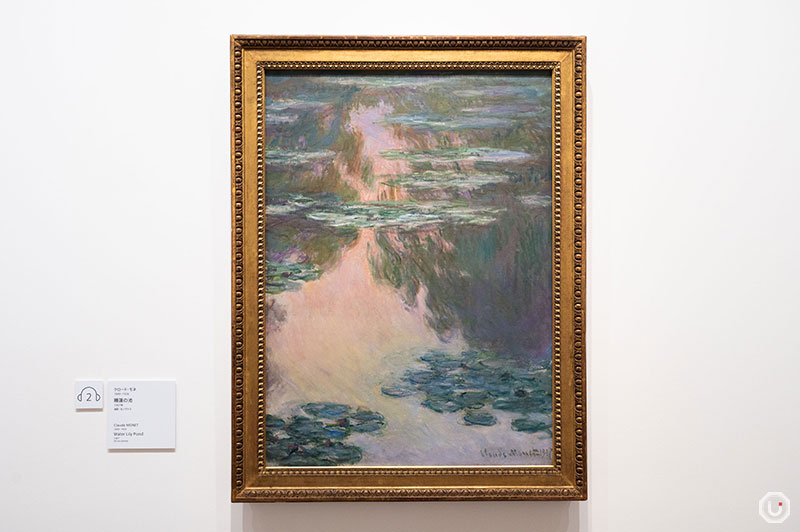
Claude Monet, Water Lilies, 1907
From the Impressionists, there is Claude Monet’s Water Lilies and Pierre-Auguste Renoir’s Mlle Georgette Charpentier Seated.
Among Japanese modern Western-style paintings, the museum houses Shigeru Aoki’s A Gift of the Sea and Takeji Fujishima’s Reminiscence of the Tempyo Era, which has been designated as an Important Cultural Property. The Artizon Museum’s collection has received high acclaim.
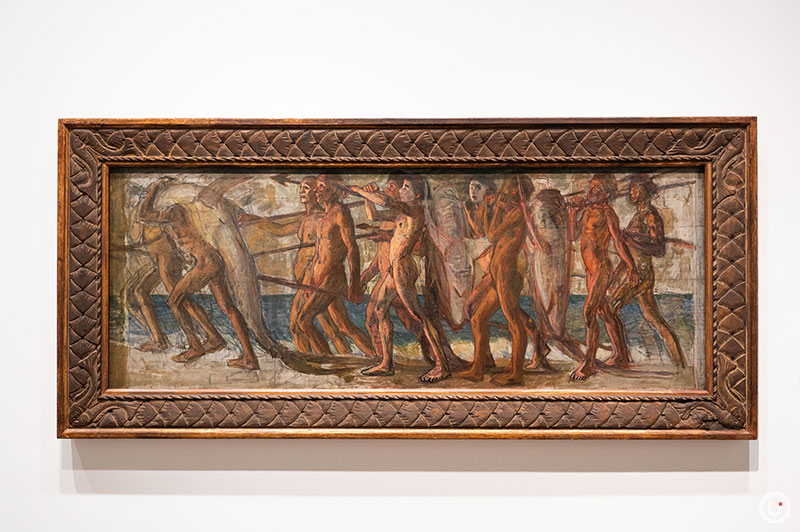
Shigeru Aoki, A Gift of the Sea, 1904
Artizon Museum Information
| Facility name | アーティゾン美術館 Artizon Museum |
|---|---|
| Address | 1-7-2 Kyōbashi, Chūō-ku, Tokyo
|
| Phone number | 050-5541-8600(”Hello Dial” general information) |
| Hours | Tues-Thurs & Sat-Sun. 10:00-18:00(last admission is 30 minutes before closing) Fri. 10:00-20:00(last admission is 30 minutes before closing) if Friday is a national holiday 10:00-18:00 |
| Closed | Monday (Except when a national holiday falls on Monday. In this case, the museum is open on the holiday and is closed the next day), New Year’s holidays Unscheduled holidays due to exhibit changes |
| Admission fee | General admission varies by exhibition; please check the museum’s official website for details Free for university school students, vocational school students, and high school students (ages 16 to 18, reservation required via the museum’s official website; student ID must be presented) Free for junior high school students (ages 13 to 15) and younger Free for visitors with a disability certificate (including one accompanying person; disability certificate required) timed-entry reservations required; available via the official website or at the museum counter tickets can be purchased at the museum counter on the day only if there are open reservation slots one exhibition ticket grants admission to all exhibitions held concurrently |
| Pamphlets | Available with Japanese, English, Chinese, and Korean language |
| Exhibit audio guides | Available with Japanese, English, Chinese, and Korean language |
Mitsui Memorial Museum: a treasure trove of Japanese art—from tea utensils and swords to paintings
The Mitsui zaibatsu (financial conglomerate) originated from a kimono shop founded by the Mitsui family during the Edo period and was known among Japan’s largest financial conglomerates before World War II.
The Mitsui Memorial Museum is a museum that exhibits art pieces collected by the Mitsui family since the Edo period, housing and displaying excellent artworks from Japan and the East, including tea ceremony utensils, paintings, swords, and crafts.
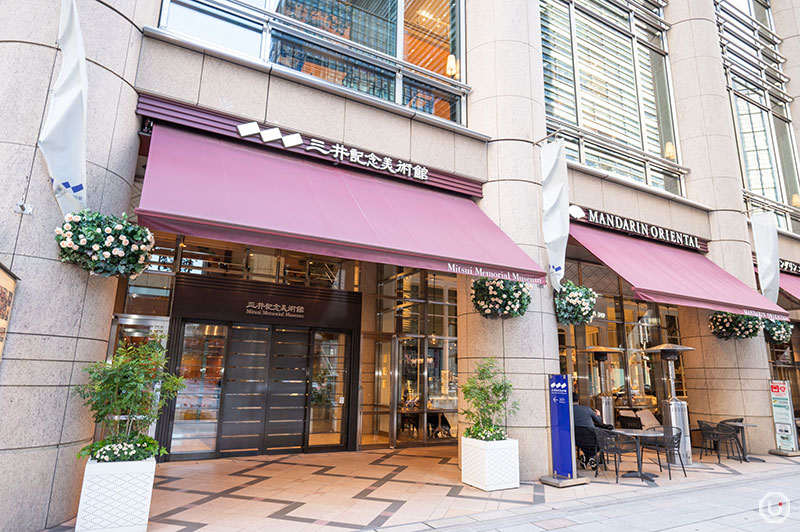
Entrance to the Mitsui Memorial Museum
Located on the 7th floor of the Mitsui Main Building, which is itself designated as an Important Cultural Property, the museum preserves the architectural atmosphere of its original era.
In other words, the museum building itself is a historical artifact. The stately Western-style elevators, wall and pillar decorations—no detail inside the building should be missed!
The entrance is located in the first-floor atrium of the Nihonbashi Mitsui Tower adjacent to the Mitsui Main Building, allowing visitors to also enjoy the transition of architectural styles from modern to contemporary.
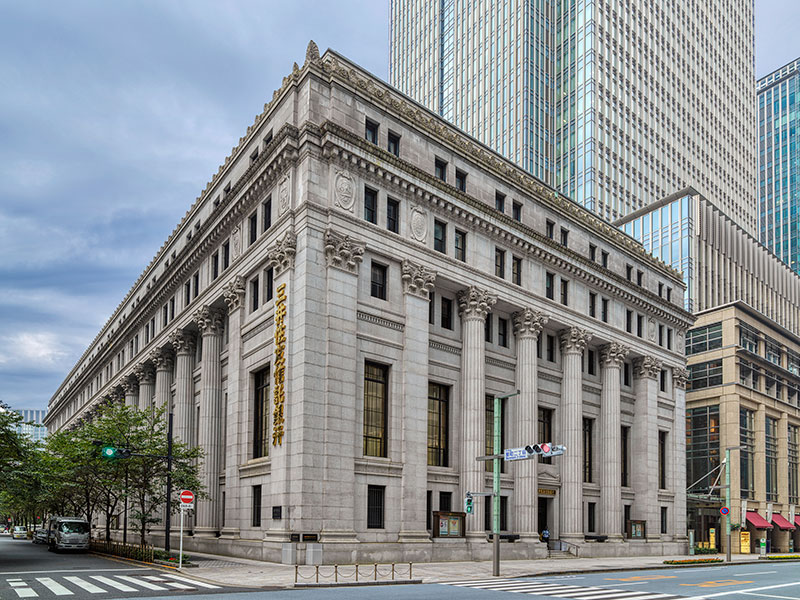
©Mitsui Memorial Museum
Notable works
The museum houses approximately 4,000 works, including six National Treasures and 75 Important Cultural Properties. Notable among them is Pine Trees in the Snow, a National Treasure and a masterpiece by Maruyama Ōkyo.
The museum hosts five exhibitions annually, combining rotating in-house exhibitions built around specific themes with special exhibitions featuring works borrowed from other collections.
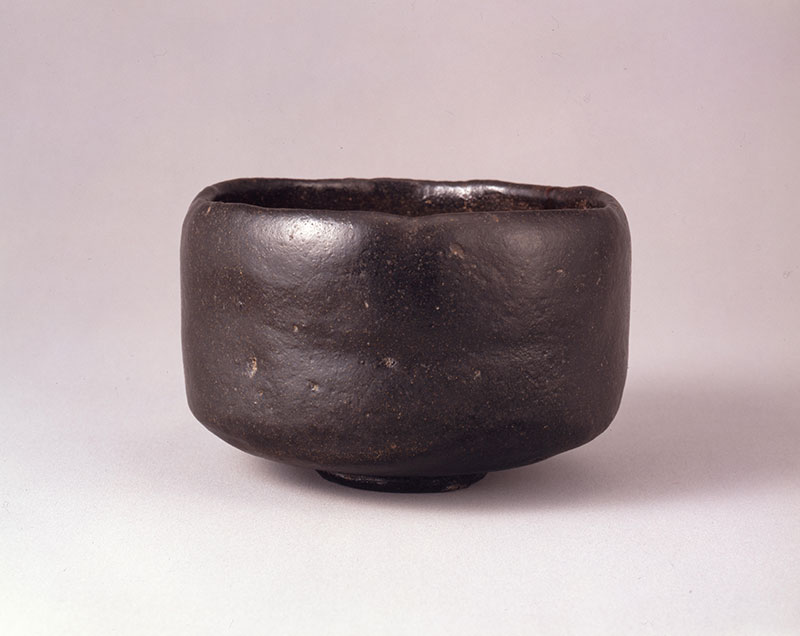
Important Cultural Property: Black Raku Tea Bowl, named “Shunkan”, Mitsui Memorial Museum Collection
The majority of the museum’s collection consists of tea ceremony utensils, including the National Treasure Shino Tea Bowl, named “Unohanagaki”, the Important Cultural Property Black Raku Tea Bowl, named “Shunkan”, and the Chinese-style Katatsuki Tea Caddy (Kitano Katatsuki), among many other renowned and exceptional works.
Special exhibitions featuring artworks beyond the museum’s collection often focus on Buddhist art, Shinto art, tea ceremony, lacquerware, and Edo-period paintings.
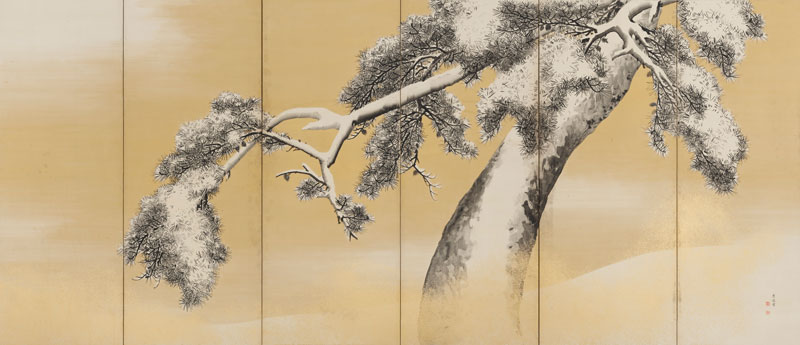
National Treasure: Pine Trees in the Snow Folding Screen (Right Panel), Mitsui Memorial Museum Collection
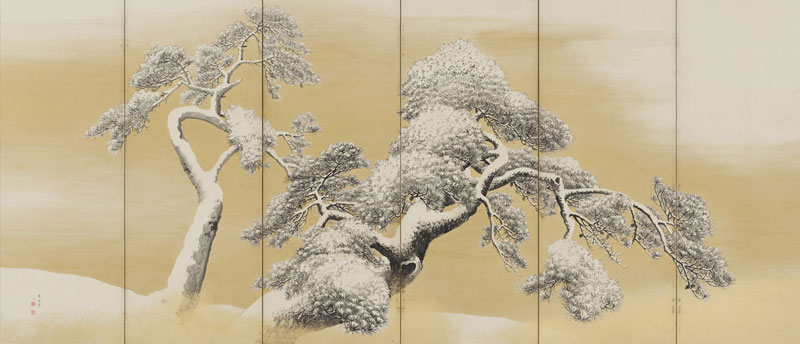
National Treasure: Pine Trees in the Snow Folding Screen (Left Panel), Mitsui Memorial Museum Collection
Mitsui Memorial Museum original goods: Japanese motifs with a sense of style
The museum shop attached to the museum offers a variety of original goods. These include tenugui (hand towels) and acrylic keychains or tote bags featuring designs based on tea bowls from the collection.
Other highlights include goshuin (special seals obtained at Japanese shrines and temples as proof of pilgrimage) featuring sword motifs. Miniature folding screen decorations are also sold as original museum merchandise.

Mitsui Memorial Museum original tenugui hand towel 1,100 JPY each (tax included)
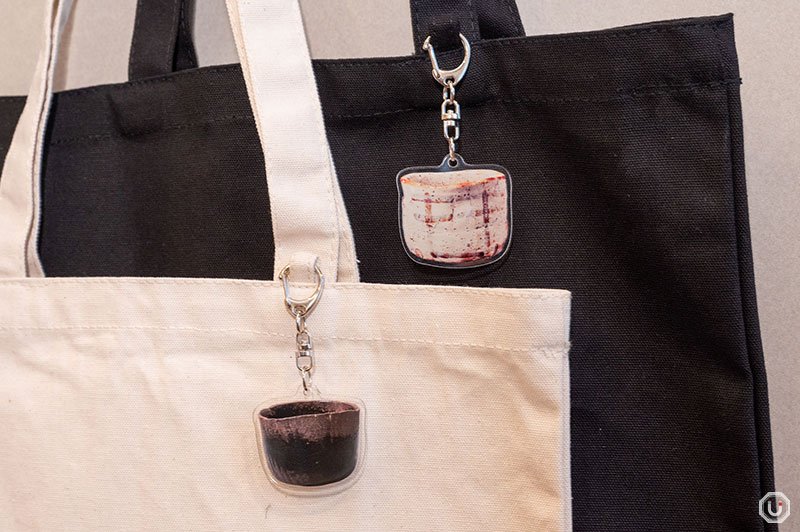
(left) Important Cultural Property: Black Raku Tea Bowl, named “Amagumo”, by Hon’ami Kōetsu acrylic keychain, 770 JPY (tax included) (right) National Treasure: Shino Tea Bowl, named “Unohanagaki” acrylic keychain, 770 JPY (tax included))
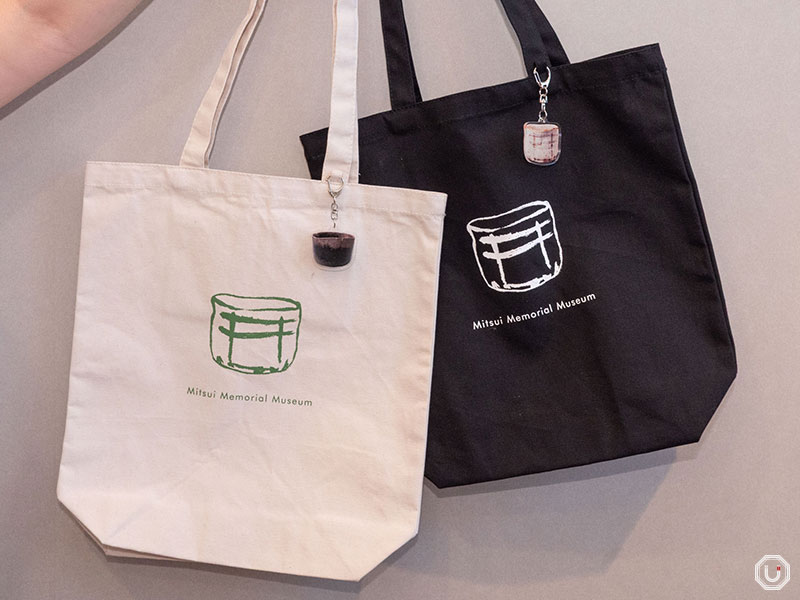
Shino Tea Bowl, named “Unohanagaki” original tote bag 1,500 JPY (tax included) 1,500 JPY (tax included)
Some items change depending on the theme of the current collection or special exhibition. Keep an eye out for limited-edition goods available only during specific exhibitions.
Unique items—take-home art pieces in their own right—await your discovery!
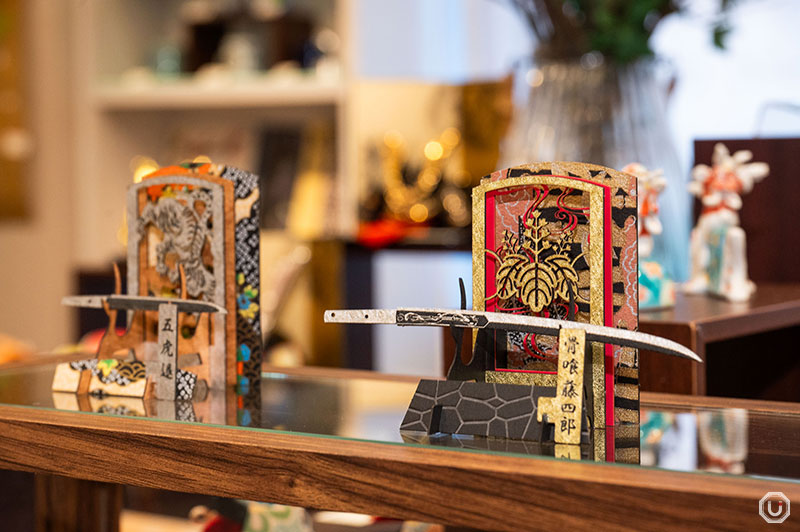
Merchandise sold as part of the “National Treasure Swords, Historic Armor, and Warriors Paintings” exhibit
Mitsui Memorial Museum Information
| Facility name | 三井記念美術館 Mitsui Memorial Museum |
|---|---|
| Address | Mitsui Main Building. 7F, 2-1-1 Nihonbashi Muromachi, Chūō-ku, Tokyo
|
| Phone number | 050-5541-8600(”Hello Dial” general information) |
| Hours | 10:00-17:00(last admission is 30 minutes before closing) |
| Closed | Monday (Except when a national holiday falls on Monday. In this case, the museum is open on the holiday and is closed the next day) Unscheduled holidays due to exhibit changes, New Year’s holidays |
| Admission | Collection Exhibition General admission 1,200 JPY (tax included) for groups of 20 or more, or for visitors aged 70 and over 1,000 JPY (tax included) University students and high school students (ages 16 to 18) 700 JPY (tax included) for groups of 20 or more 600 JPY (tax included) Free for junior high school students (ages 13 to 15) and younger Special Exhibitions General admission 1,500 JPY (tax included) some special exhibitions may have a different price for groups of 20 or more, or for visitors aged 70 and over 1,300 JPY (tax included) University students and high school students (ages 16 to 18) 1,000 JPY (tax included) for groups of 20 or more 900 JPY (tax included) Free for junior high school students (ages 13 to 15) and younger |
| Pamphlets | Available with Japanese, English, Chinese, Korean, and French language museum overview brochure only |
| Exhibit audio guide | Available with Japanese language |
ART AQUARIUM museum GINZA: a fusion of traditional and contemporary art
The ART AQUARIUM museum GINZA displays works that express the culture of goldfish appreciation, a tradition that has continued since the Edo period, in a contemporary way.
The museum is located on the 8th floor of the new wing of Ginza Mitsukoshi, a department store that first opened in 1930. Visitors enter from the 9th floor and take an escalator down to the 8th, where a dreamlike space awaits.
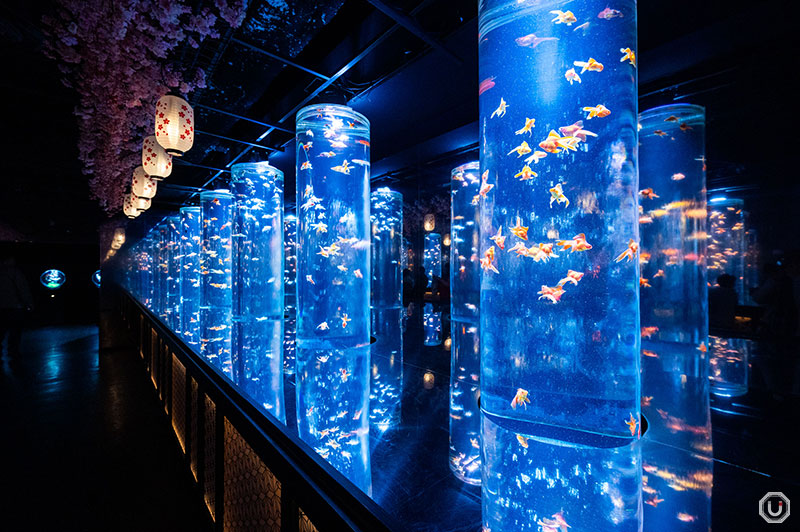
“Goldfish corridor” at the entrance of ART AQUARIUM museum GINZA
While many museums typically prohibit photography of exhibits, the ART AQUARIUM museum GINZA allows photography throughout all areas of the museum.
There are photo spot guides throughout the museum, and the official website even offers tips for taking great pictures with people, making this a unique and photography-friendly experience.
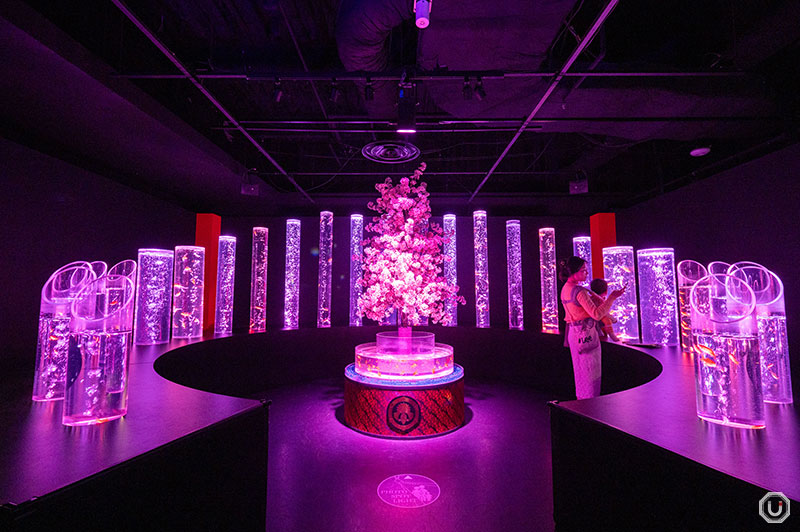
The “goldfish bamboo forest,” a popular photo spot
Another highlight is the museum’s seasonal interior design. From cherry blossoms in spring to wind chimes and fresh greenery in summer, autumn foliage, and snowy winter scenes, the decor transforms throughout the year.
The exhibits incorporate staging elements consisting of light, sound, and fragrance, stimulating the visual, auditory, and olfactory senses to provide a totally immersive art appreciation experience.
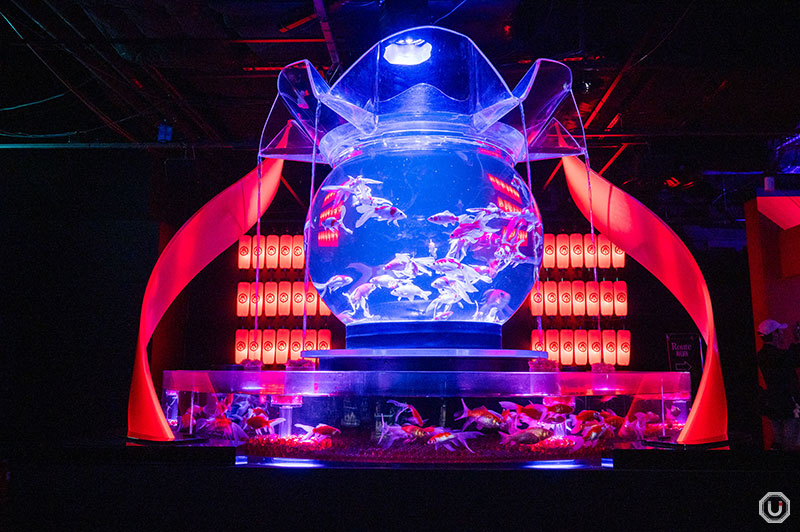
The museum’s signature “Oiran Belt Dance (OBIMAI)” exhibit
Notable works
The ART AQUARIUM museum GINZA breeds and exhibits approximately 70 types of goldfish (as of April 2025).
The “A Show of Kingyo [New Version]” area (kingyo meaning goldfish in Japanese) allows visitors to view goldfish swimming in square tanks from above.
With over 20 tanks, each containing a different variety—including some rare and precious breeds—you’ll discover subtle beauty in their patterns, fin shapes, and even individual differences within the same variety.
![A Show of Kingyo [New Version] at ART AQUARIUM museum GINZA](https://umamibites.com/wp-content/uploads/2025/04/13_250408_174.jpg)
During spring, the tanks at “A Show of Kingyo [New Version]” were adorned with cherry blossoms
The museum also features exhibits that blend traditional Japanese craftsmanship and culture with contemporary art.
One such example is “Kutani Goldfish Evaluation,” a bold exhibit that uses kutani ware, a traditional Japanese porcelain craft, as tanks.
The museum’s original emblem is even worked into the designs, making both the goldfish and the tanks themselves worth a closer look.
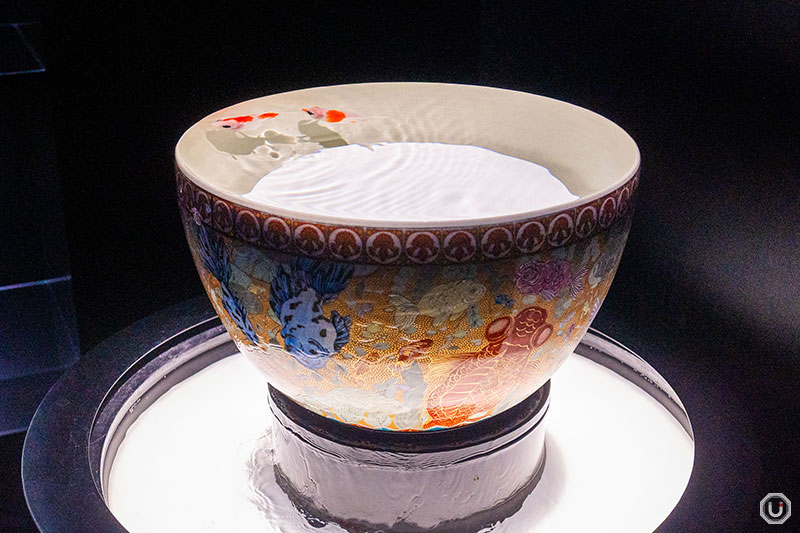
“Kutani Goldfish Evaluation” uses original kutani yaki tanks from the museum
“Shojirium,” inspired by the paper sliding doors incorporated in traditional Japanese houses, and “Oiran Flower Dance (HANAMAI),” a collaboration with a famous Japanese ikebana artist, are also stunningly beautiful.
You can explore the exhibition area in about an hour, but if you plan on taking photos, even two hours might not feel like enough time.
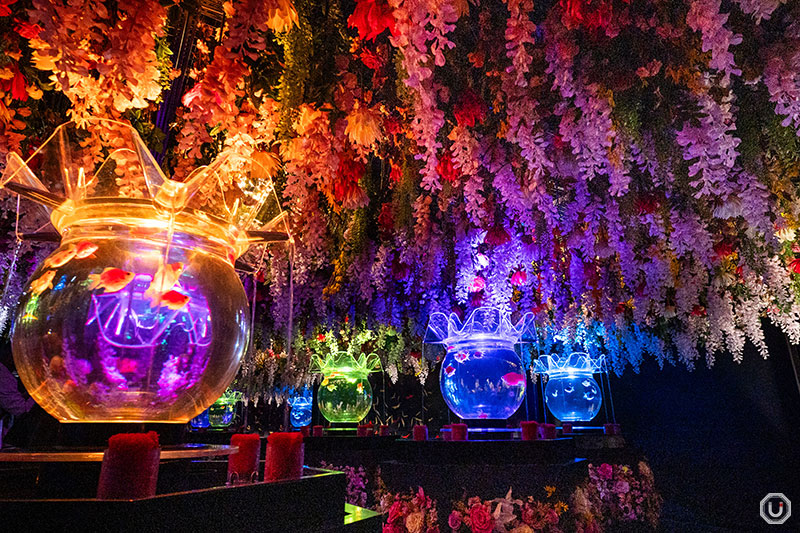
“Oiran Flower Dance (HANAMAI),” perfect for social media
ART AQUARIUM museum GINZA original goods: collaborations with Hello Kitty
The museum shop features original merchandise including stickers and acrylic keychains in collaboration with Hello Kitty, who enjoys high popularity even among overseas celebrities.
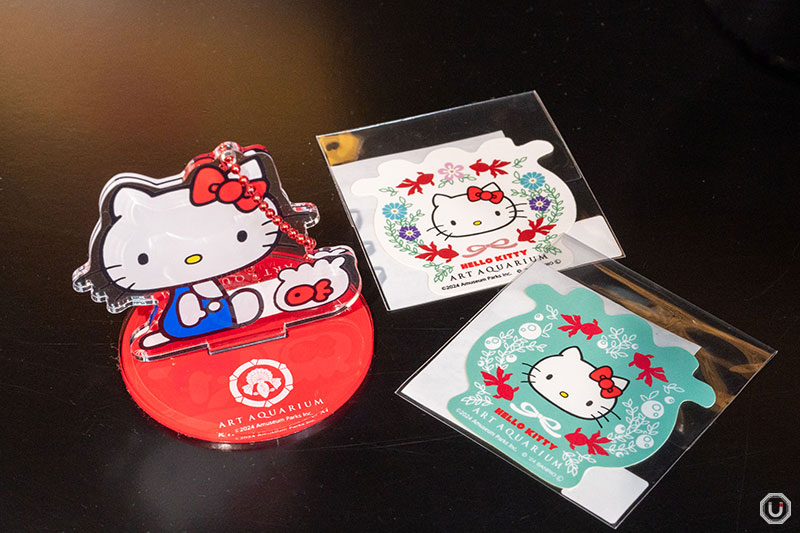
(left) acrylic keychain 750 JPY (tax included), (right) stickers 500 JPY (tax included)
Among the many goods, the plush goldfish toys are especially popular. Available in three sizes (M, L, and XL), these three-dimensional, stylized plushies are irresistibly cute—you’ll find yourself reaching for one without thinking.
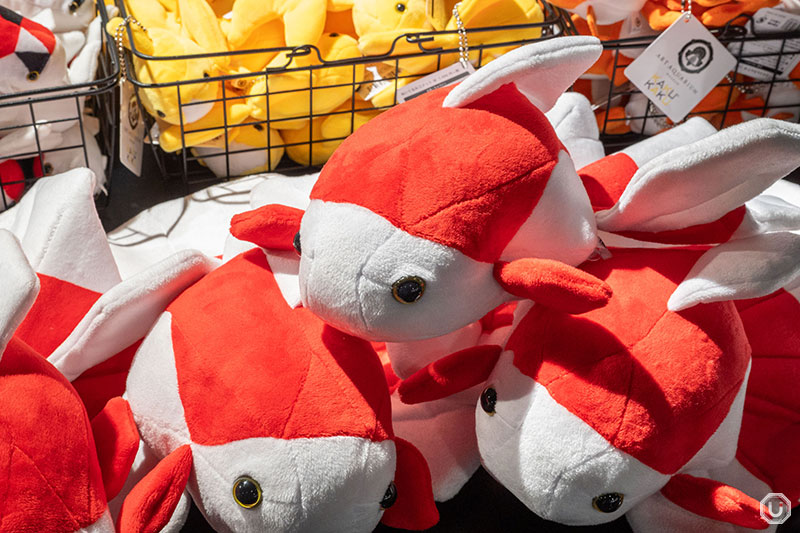
original plush toy (M) 1,540 JPY (tax included)
You can also get an alphabet keychain, sure to please, whether for yourself or as a gift. Since each one has a different design, why not try and find the perfect one for you?
ART AQUARIUM museum GINZA Information
| Facility name | アートアクアリウム美術館 GINZA ART AQUARIUM museum GINZA |
|---|---|
| Address | Ginza Mitsukoshi, 4-6-16 Ginza, Chūō-ku, Tokyo (Admission: New Building 9F)
|
| Phone number | 03-3528-6721 |
| Hours | 10:00-19:00(last admission is one hour before closing) |
| Closed | No holidays Please check the official website for any changes |
| Admission | Same-day admission ticket from vending machine 2,700 JPY (tax included) Online-exclusive admission ticket 2,500 JPY (tax included) |
| Pamphlets | Available with Japanese and English language |
| Exhibit audio guide | None |
